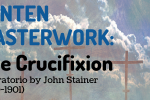The Crucifixion: A Choral Masterwork for Lent

On April 7, at 4 p.m., the St. Bart’s Music Ministry will present a large-scale dramatic work, The Crucifixion, by British composer John Stainer (1840-1901). In collaboration with the Parish Choir, the String Ensemble will accompany the work, with added musicians from our parish and the local community. The piece is a dramatic, contemplative, seldom-performed Romantic oratorio, with solos, choruses, instrumental passages, and even hymns for the congregation to participate in. Our hope is that this is the beginning of an annual St. Bart’s tradition to present a large musical work in the season of Lent: a Passion, Mass, or other appropriate work for the season.
What is an oratorio? It helps that my Master’s Thesis happens to be on the development of oratorio through Georgian Britain (1714-1830), so I should be able to provide a comprehensive definition. Oratorio began as sacred dramatic music being performed in an ‘oratory’, or small chapel, and evolved into unstaged presentations of drama that have narrative elements and use texts from sacred sources. Several of Handel’s oratorios are therefore misclassified as oratorio as they use texts from mythological sources rather than sacred (Hercules, Semele, et al.). As well, despite being unstaged, oratorios are very dramatic, with vivid interpretations of text through the musical subtlety. We often have the plot advanced through recitative sections, usually by soloists, and then the chorus will respond with emotional reflections on the drama, and often contextualize the plot into
What is the piece about? The Crucifixion depicts the Passion of Christ, from the scene in Gethsemane to Jesus’ death, with several contemplations along the way on the story’s context and perspective. The music is filled with very contrasting sequences, as the music will often go from ff (very loud) to pp (very soft) in a matter of seconds. The orchestration is colored with various motivic elements, as the woodwinds will be used in more contemplative sections, and the brass and drums will occur in more brazen parts. One will find themselves hard-pressed to become disengaged from the drama, as Stainer manages to keep the listener on the edge of their seat throughout.
It is through your support that we are able to present these large-scale concerts, and we thank you in advance for your attendance and generosity. We look forward to seeing you on April 7 for our collective exploration and ingestion of the Passion story as we continue on our Lenten journeys.

Comments
Login/Register to leave a comment